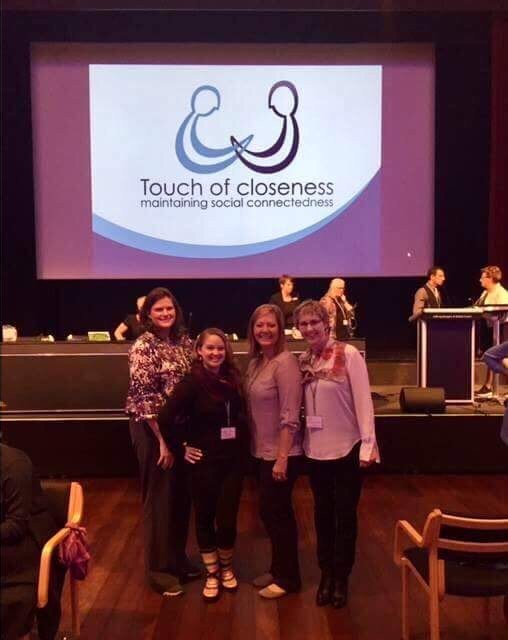9th European Deafblind International Conference, Aalborg, Denmark
Brooke Barnhill (Cohort 1 Scholar), Tara Brown-Ogilvie (Cohort 2 Scholar), Kristi Probst (Cohort 1 Scholar), and Bernadette Van Den Tillaart (Cohort 2 Scholar)

From left to right: Brooke Barnhill (Cohort 1 Scholar), Tara Brown-Ogilvie (Cohort 2 Scholar), Kristi Probst (Cohort 1 Scholar), and Bernadette Van Den Tillaart (Cohort 2 Scholar)
The 9th European Conference of Deafblind International (DbI), held approximately every three years, took place in the first week of September 2017 in Aalborg, Denmark. Although most attendees came from European countries, DbI members from all other continents were present. Four scholars in deafblindness from both cohorts of the National Leadership Center on Sensory Disabilities were among the participants from the United States: Bernadette Van Den Tillaart, Kristi Probst, Tara Brown-Ogilvie and Brooke Barnhill.
The conference theme was reflected in the keynote speeches and panels about closeness (touch) and connectedness. One of the goals was to connect the two sides of deafblindness: congenital and acquired deafblindness, for them to learn from each other. This resulted in an almost even amount of presentations related to these two sides. (We use here the word deafblindness in accordance with the wording used at the European DbI Conference, although we recognize that DeafBlind and deaf-blind could have been used as well.)
The conference provided us with a wealth of information about the use of touch to maintain social connectedness with individuals who are deafblind. We heard personal accounts from individuals who are deafblind and how touch is such an integral part of their lives. We felt it was so important for these individuals to share their stories both for their voices to be heard and for them to provide leadership on this topic and for the professionals to hear. We also learned from many practitioners and researchers in the field. One of them was Brooke. She was a co-presenter in a greatly received presentation about the use of creative dance through the BEST-model with students who are congenitally deafblind. Another one was Tara. She presented a clear and well visited research poster about the needs in deafblindness related to Orientation and Mobility training. Bernadette chaired workshops and was involved with the networks. Kristi could join us last minute at this conference.
Some of the biggest takeaways/reminders for our work were:
* It is imperative that we frame activities and dialogues for our learners as they are working to increase their communication as we want to not discourage the growth of language, but for it to grow.
* Too often, people look at what an individual can't do. The only way to truly start and/or develop the child's education program is to know about what they CAN do. Don't ask them "What can you do?" rather, ask them "What DO you do?
* Touch and proprioception take priority over vision and hearing...everything depends on the sensory systems. Get balance (proprioception and vestibular) under control and the child's brain will be ready to engage.
* Posture of the child: often people do not take the time to understand why a child is sitting in a certain way, they just make them "sit correctly." We need to figure out what the function of the posture is (is it to: ground the child, provide more stability, etc). If we stop the posture before understanding it, the child's self-regulation will decrease and they will be unable to engage in the activity.
* We can use creative dance to teach concepts to children. It is a great way to honor any type of engagement they offer and draw their peers in.
* My take away from Deafblind International (DbI), was not only an emphasis on touch, but also movement.
* Listening to the key note speakers, they spoke passionately on the topic of social isolation and its ability to lead to stagnation of mind and body. I left with a quote from a speaker who is deafblind himself that shook me to my core, “It is not like getting a terminal illness and dying, but in some ways, isolation can kill something inside of you and leave you as an empty shell of human flesh”. As dark as the speaker painted this statement in his message, I feel that he really wanted to emphasize the importance of looking at the holistic nature of serving those with deafblindness.
* While on this tour, I had the wonderful opportunity of meeting Dr. Lauren Lieberman, an expert in adaptive physical education and co-author of Physical Education and Sport for Individuals Who are Visually Impaired or Deaf-Blind: Foundations of instruction, who further stressed the need for physical movement and activity to truly engage individually with sensory disabilities.
* Overall, I enjoyed learning about the progress of dual sensory services around the world, networking with great minds, and leaving with a new ambition of incorporating purposeful movement into services for those with sensory disabilities.
*"We have a small field, but more research is needed!"
This conference gave us the rare opportunity to be with colleagues and people for whom deafblindness is their professional or personal world. Networking with many across the world, with several NLCSD - PAC members, but also amongst us as four NLCSD scholars in deafblindness was very important for our future research endeavors. Thank you NLCSD for the indispensable conference support! We hope to attend the first-ever DbI Conference of the Americas in April 2018!
-- Brooke Barnhill, Tara Brown-Ogilvie, Kristi Probst, and Bernadette Van Den Tillaart